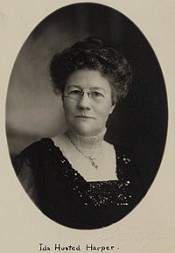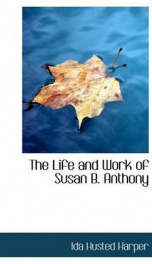Harper Ida Husted

Ida Husted Harper (February 18, 1851 – March 14, 1931) was a prominent figure in the United States women's suffrage movement. She was an American author and journalist who wrote primarily to document the movement and show support of its ideals. Ida was born in Fairfield, Franklin County, Indiana to John Arthur Husted and Cassandra Stoddard. By 1870, she was a school teacher in Peru, Indiana. Later, she bcame a principal of a high school in Peru, Indiana and on December 28, 1871, she married Thomas Winans Harper of Terre Haute, Indiana, who went on to become a successful attorney and politician and whom she would later divorce. She began writing woman's columns, first in a Terre Haute newspaper under the pseudonym "John Smith" and later in a union magazine edited by activist Eugene V. Debs of Terre Haute. Through this period, she increasingly became more interested in the campaign for women's suffrage. In 1887, she helped to organize a woman suffrage society in Indiana, serving as its secretary and in 1896 joined the National American Woman Suffrage Association where she worked as a reporter and, ultimately, an historian of the movement. She brought Susan B. Anthony to Terre Haute for a suffrage convention and became close to her during this period, soon collaborating with her on the "History of Woman Suffrage". She later wrote an authorized and substantial biography of Anthony based on her their relationship and Anthony's own archives. The Life and Work of Susan B. Anthony was published in 3 volumes between 1898 and 1908. Seeking to cement her place in history as Anthony's sole biographer, she spent weeks burning priceless letters and historic documents after the main text was in place.[1] Ida Harper fulfilled a similar role in press relations for the International Council of Women and later headed the Leslie Bureau of Suffrage Education, which strove to improve public understanding of the movement. The bureau produced articles and pamphlets about the campaign and also communicated directly with editors, praising, chastising, or correcting them regarding their editorial policies on women. In 1920, her efforts contributed to the success of the movement as women were guaranteed the right to vote by the Nineteenth Amendment. In 1922, she updated the History of Woman Suffrage, adding fifth and sixth volumes. She died in Washington, D. C. in 1931. Her daughter, Winnifred Harper Cooley, became an author and lecturer.
do you like this author?
What readers are saying
What do you think? Write your own comment on this book!
write a commentWhat readers are saying
What do you think? Write your own comment on this author!
write a commentBook list

The Life and Work of Susan B. Anthony (Volume 2 of 2)Including Public Addresses,Her Own Letters and Many FromHer Contemporaries During Fifty Years
Series:
Unknown
Year:
Unknown
Raiting:
4.5/5
Show more
add to favoritesadd In favorites

The Life and Work of Susan B. Anthony (Volume 1 of 2)Including Public Addresses,Her Own Letters and Many From HerContemporaries During Fifty Years
Series:
Unknown
Year:
Unknown
Raiting:
3/5
Show more
add to favoritesadd In favorites

the life and work of susan b anthony including public addresses her own lette
Series:
Unknown
Year:
Unknown
Raiting:
2.5/5
Show more
add to favoritesadd In favorites
Book list

The Life and Work of Susan B. Anthony (Volume 2 of 2)Including Public Addresses,Her Own Letters and Many FromHer Contemporaries During Fifty Years
Series:
Unknown
Year:
Unknown
Raiting:
4.5/5
Show more
add to favoritesadd In favorites

The Life and Work of Susan B. Anthony (Volume 1 of 2)Including Public Addresses,Her Own Letters and Many From HerContemporaries During Fifty Years
Series:
Unknown
Year:
Unknown
Raiting:
3/5
Show more
add to favoritesadd In favorites

the life and work of susan b anthony including public addresses her own lette
Series:
Unknown
Year:
Unknown
Raiting:
2.5/5
Show more
add to favoritesadd In favorites

life and work of susan b anthony volume 1 of 2 8 0
Series:
Unknown
Year:
Unknown
Raiting:
2.5/5
Show more
add to favoritesadd In favorites

The Life and Work of Susan B. Anthony (Volume 1 of 2)
Series:
Unknown
Year:
Unknown
Raiting:
3.5/5
Biographical work by Ida Husted Harper, an American author and journalist of the 19th – early 20th centuries. It is devoted to prominent American civil rights leader who played a pivotal role in the 19th century women's rights movement to introduce women's suffrage into the United States, Susan Brownell Anthony.
Show more
add to favoritesadd In favorites
What readers are saying
What do you think? Write your own comment on this author!
write a commentif you like Harper Ida Husted try:
readers also enjoyed
What readers are saying
What do you think? Write your own comment on this author!
write a commentGenre
if you like Harper Ida Husted try:
readers also enjoyed
Do you want to read a book that interests you? It’s EASY!
Create an account and send a request for reading to other users on the Webpage of the book!

